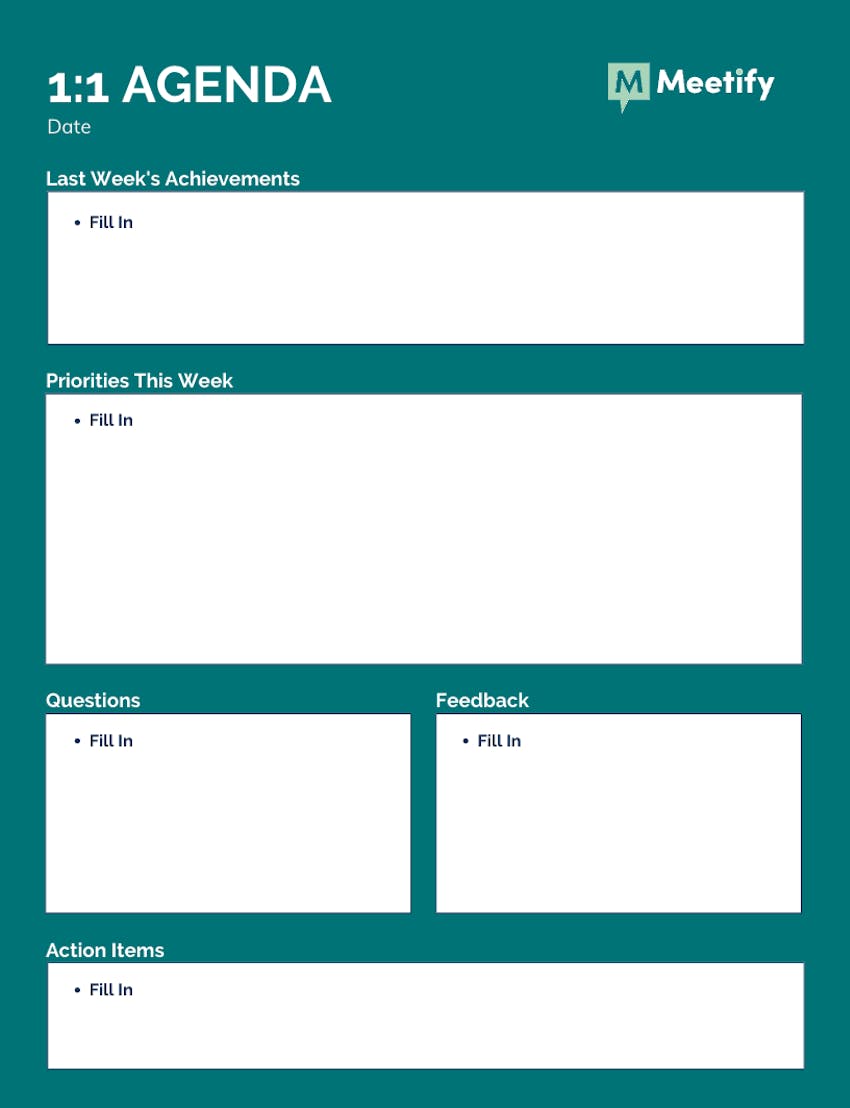
How to Hold More Productive One-on-One Meetings
Julie David
One-on-one meetings are a powerful tool to equip team members to execute on the company's mission. Employees who have regular one-on-one meetings with their supervisors are three times more likely to be engaged according to a Gallup poll on great managing.
This is because these meetings are really about the relationship between two people who are working together towards accomplishing a mission. Following these tips and best practices to retool your one-on-one meetings will ensure they're productive and efficient, while leaving both people confident of the impact their making together.
What To Do Ahead of the Meeting
Be collaborative about the agenda
Communicating a shared vision for the meeting agenda is critical to its success. Management thought leader Russ Laraway states that letting the employee take the lead on creating the agenda is a “simple, symbolic practice that helps them feel ownership and autonomy for their work and their time.” Hello, who doesn’t want to feel ownership over their work?
Develop a one-on-one meeting agenda template. Then make it a practice for your meeting partner to fill in the agenda and send it to you with enough time for a quick review to finalize it before you meet.
Extra Tip: A good rule of thumb is the agenda prep should take a minute to prep for every 2-3 minutes you’ll meet. This may seem like a lot of prep, but a meeting with a well prepared agenda will significantly reduce the time needed to meet. Use this editable agenda, or check out other one-on-one meeting agenda templates.
Review past one-on-one meetings
Just as a good doctor reviews your chart before seeing you, a good manager should review notes from past one-on-one meetings to ensure continuity and constructive follow up between meetings. You can encourage this process even further by asking the team member to look over past notes and follow up on any lingering questions or needs by adding them to the next one-on-one agenda.
Scheduling a one-on-one as an in person meeting in a relaxed setting from time-to-time gives managers an opportunity to build more authentic relationships. This is especially useful if you want to ensure open communication and trust, qualities that are a must in relationships that lead to meaningful work. Meeting face-to-face also makes it easier to pick up important information from body language to guide the interaction. The ability to talk over a beverage or meal can add a social element that builds the connection, too.
Extra Tip: Use an in person meeting scheduler like Meetify to find a central spot and a good time to meet.
Pick a productive time
Not everyone is a morning person, so try to schedule your meetings at a time when one-on-one conversations will be naturally constructive for both people. It's also important to schedule a consistent time when you'll both be available. A study by a scheduling software company found that the optimal time for meeting is 2:30 p.m. on Tuesday since it’s when the most people are available. If you decide to meet over a mealtime, make sure food is included. When a meeting’s efficiency is key, make it a brief, stand up meeting.
What To Do During the Meeting
Take Collaborative Notes
Having a collaborative platform for meeting notes strengthens communication and solidifies the outcomes reached during a one-on-one. Laraway lists this as a great way to capture action items, what’s decided and what’s due.
Expert Tip: If your team doesn’t already have a tool for collaborative docs, consider using Google docs and make a folder for each set of one-on-one meetings you attend. That way, you can set the folder permission to allow collaboration between the same meeting attendees.
Listen actively
Active listening means not just listening to be polite but listening to do something with the information being communicated. Make it a habit to ask clarifying questions and use phrases like, “What I hear you saying is . . .” and “This is important. Let’s make sure it gets written down.” This communicates that what is being said is clear, valuable and will be acted on.
Ask Purposeful Questions
To make your meetings effective, pick questions best suited for your time frame and goals. It’s helpful to have a few questions that get asked regularly. Our brains thrive on this consistency. After a couple meetings, you’ll notice that you’re both ready to dive into your next one-on-one because your brains have been collecting information that needs to be discussed related to these expected topics. Here are a few useful questions to get started:
- How are you feeling at work during this season?
- What parts of your role are going well?
- What parts of your role are you finding challenging?
Expert Tip: After using the same questions for some length of time, you’ll notice one or both of you start to go through the motions as the questions become too routine or your business reaches a new stage. That’s the time to switch it up with new questions.
Pause before advising
If your meeting partner has identified some areas of struggle, you can ask what their next steps might be before throwing your advice into the mix. If they seem at a loss, this can be an appropriate time to share a related story of growth or ask if they’d like your advice. Be very mindful if you’re in the habit of being a storyteller or being a quick problem solver. When one-on-ones become heavily one sided instead of conversations, productivity can come to a halt.
Focus on strengths
A poll found that when managers took a “weakness-fixing” approach to employee development, 22% of employees were actively disengaged from their work. However only 1% were disengaged if their manager focused on their strengths. While there is a time and place for coaching and correcting, your goal for regularly scheduled on-on-ones is to receive information and make sure your employee walks away feeling heard and equipped for the work ahead.
What To Do After the Meeting
Make 1:1s recurring
One-on-one meetings are such a vital tool for empowering employees to be successful that they should be held regularly. Use tools to schedule meetings and send reminders as well as to help with agendas and meeting notes. This way, you won’t be tempted to cancel them as your task list grows. Only cancel them when you both agree it’s not needed, and then make sure to resist canceling two or more one-on-ones in a row.
Follow up
A consistent process for following up on action items is just as critical as a solid meeting agenda. This creates a culture of trust and further affirms the value of one-on-ones. If you are the meeting owner, communicate the process of accountability for action items and ask the other person to hold you to it. If you are not the meeting owner and don’t have a follow up process, ask for one.
Ask for feedback
After running one-on-ones, consistently communicate that you’d like feedback on how to make the meetings more productive. This vulnerable request shows you value improvement, not perfection, in yourself and others. It will also lead to more productive discussions as meetings are tweaked to be more useful.
Challenges to Prepare for
Personal Needs
We all need the reminder that work is not the only thing we have on our minds during business hours. Be sensitive to challenges employees are facing outside of work and celebrate with them when they share joyful news. Genuinely ask how they’re doing when you meet and be prepared to spend extra time listening and supporting them through life’s ups and downs.
Confrontation
You will likely encounter some instances when a meeting partner feels defensive or misunderstands you. This is when, as a leader, you can take a compassionate stance, back off the topic, and pull out tools to navigate conflict. Rather than avoiding future conflict, communicate that you appreciate the opportunity to work through a challenge together and grow.
Eventual plateau
If you’ve been having consistent and productive one-on-ones, you may get to the point where you feel your time with your meeting partner is falling flat. While you shouldn’t force a conversation, it’s still important to maintain the habit of meeting. This is a good time to widen your talking points and questions to bigger company happenings or circle back to notes from previous conversations that are worth revisiting.
Well run one-on-one meetings are a simple productivity tool that amplifies good business practices and eliminates those that aren’t useful. By using these best practices that focus on building relationships and equipping staff with the tools they need to be successful, you'll not only build a more successful company, you'll enjoy doing it together.

© 2025 Meetify. All rights reserved.
Privacy Policy Terms of ServiceWe use cookies to help you have the best experience using Meetify. Click "Accept All" to consent to our use of cookies. Privacy Policy




